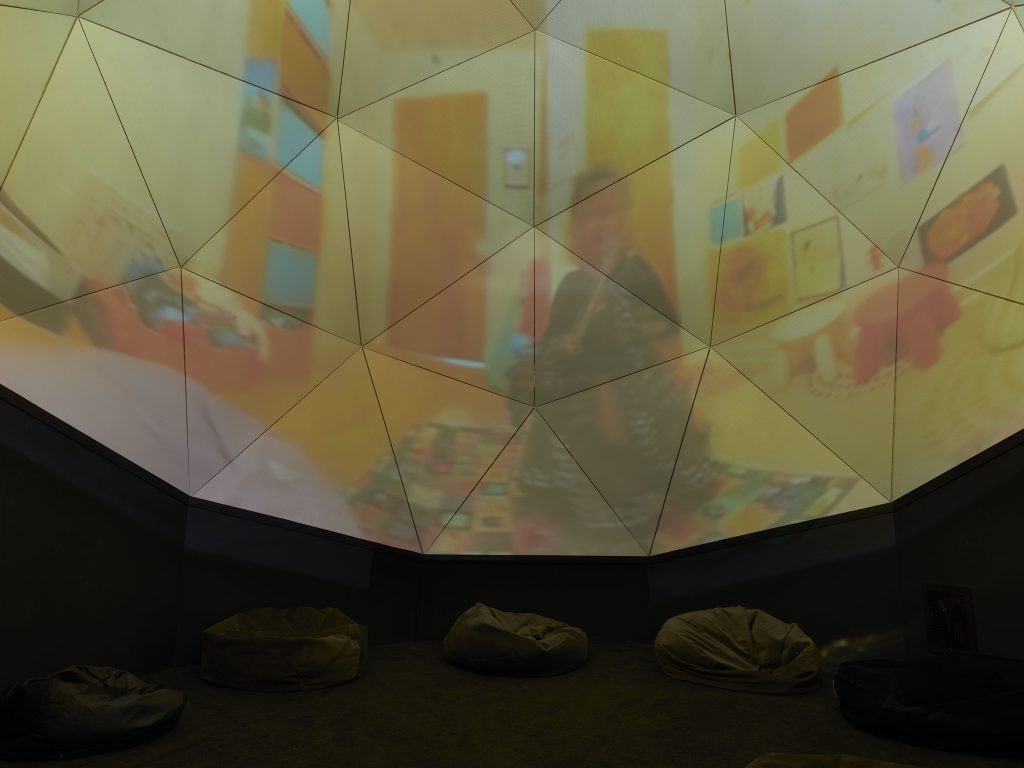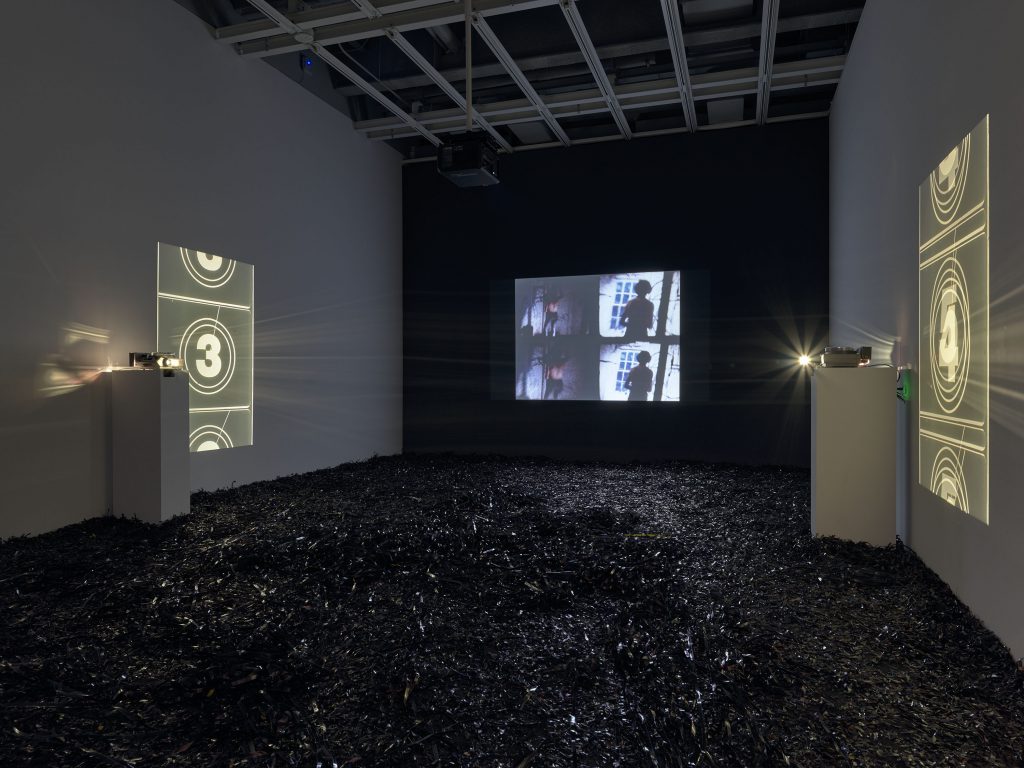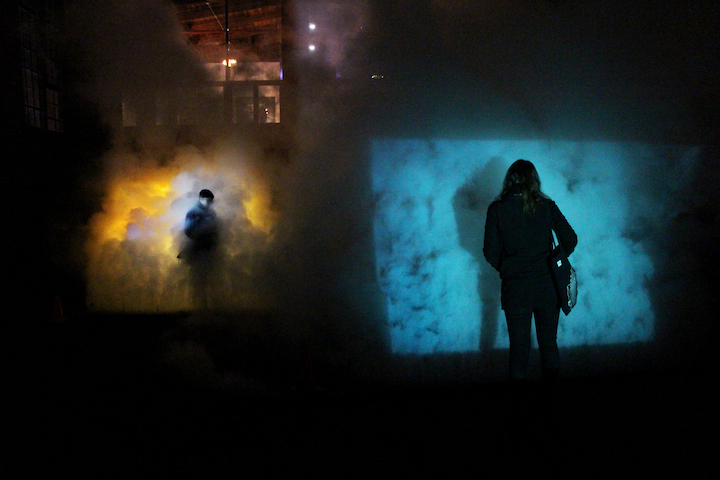Dreamlands: Immersive Cinema and Art, 1905–2016 was careful not to rely on familiar arguments or traditional forms of spectatorship. With works dating from the beginning of the twentieth century to the present, the exhibition ambitiously embraced both cinema and art through a synthesis of forms presented in the galleries of the Whitney Museum, thematic programming in the museum’s theater, and a series of off-site cinematic events at Microscope Gallery and Knockdown Center in New York.
In this exhibition, curator Chrissie Iles proposed new connections and ways of thinking through the emergence of the immersive cinematic experience. At various moments, viewers were presented with cinematic means of viewing art, and artistic means of viewing cinema. There were many ways to “see” Dreamlands, and by unifying various communities and the works created by them, Iles pointed to, and confounded, each community’s different expectations of spectatorial embodiment. For some in the art world, physical space is still held to be more important than the linear viewing experience of the cinema space, and for some in the film world, vice versa. If Oskar Schlemmer’s Triadic Ballet (1922) has been said to be a total work of art because of his comprehension of multiple forms—the creation of costumes, consideration of accompanying music, choreography, and set design—then “Dreamlands” could be referred to as approaching a gesamkunstwerk of exhibition-making: an amalgamation of forms, communities, and audiences, themselves expanded beyond the physical space of the gallery walls.
aCCeSsions editor Lola Kramer sat down with curator Chrissie Iles during the exhibition’s run to discuss how it took shape. Published in retrospect, this feature shifts the perspective from being within the gallery walls or the theater, to looking back at the exhibition’s totality.

Frances Bodomo (b. 1988), still from Afronauts, 2014. Video, black-and-white, sound; 13 min. Courtesy of the artist.
Lola Kramer
One of the striking things about this exhibition is how it presents the potential for programming to have equal weight to what takes place in the galleries. Unusually, the programming in Dreamlands comprised two-thirds of the exhibition. I’d like to talk about what was not included on the exhibition floor, but appeared elsewhere, in the film program and in the off-site programming at Microscope Gallery and the Knockdown Center, as a part of Dreamlands: Expanded.
Chrissie Iles
The film program and expanded cinema events in Dreamlands were a central part of the exhibition, but experienced linearly across time, as events. The screening program took place in the theater, in fourteen parts, each of which addressed an aspect of the exhibition in filmic terms, so that cinematic experience was folded back into the show in a way that allowed the viewer to think about the relationships between different kinds of cinematic experiences. Some of the films are more usually seen in a gallery context, just as some of the works in the galleries, such as Joseph Cornell’s Rose Hobart, are more usually screened in the theater. And some were made before either galleries or cinemas had taken concrete form. The re-presentation of Kurt Schwerdtfeger’s Reflektorische Farblichtspiele (Reflecting Color-Light-Play, 1922) at Microscope, for example, revealed another layer of complexity to the experiments of the Weimar artists Oskar Schlemmer and Oskar Fischinger, shown elsewhere in Dreamlands, in a work that was neither a film nor a conventional artwork, but a cross between architecture, sculpture, projection, performance, and an instrument that was played. Only by experiencing all these different forms would the viewer be able to experience a complete picture of both what the show was, and the complexity of how artists work with cinematic ideas.
In some cases, such as Frances Bodomo’s short film Afronauts (2014), the work was shown both in the galleries and in the film program, allowing the film to be experienced differently in both formats. In the galleries, it was experienced by a general public comprising a mainly non-film audience, and surrounded by less linear works. In the theater, it was screened as part of a group of films by young Afro-futurist women filmmakers, in a context that revealed the extent of their powerful contribution to contemporary filmmaking.
Lola Kramer
Could you speak a bit more about the Afrofuturist and “Pain Revisited” programs in the theater? You had conversations with a lot of filmmakers before composing the final screening. Would you expand on that?
Chrissie Iles
I see Dreamlands as quite political. Most people’s experience of immersive projective space is corporate, commercial, large, overly-bright. Viewers are drowned in imagery that is trying to seduce them into buying and consuming things they don’t need, speaking to the lowest common denominator, through aggressive racial, class, and gender stereotyping. This intrusive visual immersiveness extends into the street, as overly-bright street lamps create an immersive surveillance-saturated panopticon that renders shadows, darkness, secrets, and privacy impossible. In public space, particularly in urban America, immersiveness is experienced as corporate social control.
Dreamlands presents another, very different kind of immersive experience in social space, one in which our relationship to technology, to objects, and to stereotypes of gender and race is questioned. One of the key issues right now is how the network of different artistic communities within culture, including the African American community, can create a powerful collective voice. I felt it was very important that the African American contribution to new ideas of the cinematic was present in the show, in particular young women filmmakers and artists, often working collectively.

Ben Coonley Trading Futures (interior view), 2016, 360-degree 3D Video, color, sound. Collection of the artist; courtesy Microscope Gallery, Brooklyn. Installation view of Dreamlands: Immersive Cinema and Art, 1905-2016 (Whitney Museum of American Art, New York, October 28, 2016-February 5, 2017). Photograph Ron Amstutz.
Lola Kramer
Another incredible event that took place outside of the gallery was the presentation of Stan Vanderbeek and Joan Brigham’s Steam Screens (1979), organized by Microscope Gallery at the Knockdown Center. Would you tell me about this?
Chrissie Iles
We re-staged Steam Screens for the first time since it premiered at the Whitney in 1979, working closely with the VanDerBeek Estate and Joan, in a large open area outside, in the Knockdown Center. It was a cold winter night, with 20mph winds, which made the projections onto the billowing steam even more dramatic. As VanDerBeek said, there are always two performers in this piece—one is the wind and the other is the audience. To which I would also add the projectionists, who projected the films onto surfaces that were constantly moving and changing shape and size. One of the most striking things about the event was the way in which the rapidly generated swirling movements of the six steam screens alternately revealed and hid the audience as they moved around, trying to find a stable viewing point. The brief glimpses of people through the steam became part of the imagery of the work. It was extraordinary to see the steam screens in a constant state of dissipating and reappearing as the wind blew them back and forth, multiplying a time-based experience into a live form of layered image-making generated by both the screens themselves and the audience.
Lola Kramer
What is the relationship between this kind of live experience and seeing a cinematic work in the gallery?
Chrissie Iles
Event-driven experience forms the core of expanded cinema’s meaning. The work happens in the moment, and will never be experienced in the same way again. Each performance of it is unique. Some expanded cinema works are also installation-based, like Takahiko Iimura’s Circle and Square (1981), presented at Microscope Gallery. The work hadn’t been shown in its installation form since it was first made. But it also has a live element. Iimura projected a film of black leader through the projector in a big loop that stretched from the projector up to and across the ceiling, then down into his hands as he sat in a chair in the middle of the space, holding a hole puncher. Every so often, he would punch a hole in the film, which, when it got back to the projector, would appear as a white circle projected onto the wall. On the other side of the room, another projector projected light back onto the hole-punched film as it moved in its large loop, throwing a shadow of it onto the wall. So on one wall we could see an image of a circle created by the artist cutting basically a stencil in real time, and on the opposite wall we could see the shadow of what was creating the image, the film strip with all its small punched holes. The film ends when there are too many holes for the film to run through the projector smoothly, and it snarls up the projector and stops moving.
This is a classic example of expanded cinema. The action determines what the film is in real time, and each time, it is composed differently.
Lola Kramer
The process is the film.
Chrissie Iles
Yes. Just like the grouping of Schwertfeger, Fischinger, and Schlemmer within the show in different moments and places, this piece relates to Anthony McCall’s Line Describing a Cone (1973) and Jud Yalkut’s Destruct Film (1967), and you can only truly understand the presence of those two works in the exhibition clearly if you also experience this expanded cinema work, which deals with very similar issues, but in a way that only an expanded cinema event can.
Lola Kramer
For Dreamlands it’s really a huge part of the experience.
Chrissie Iles
It’s a huge part. The other thing about Dreamlands is that it speaks to different communities who don’t necessarily communicate with each other, and the show attempted to bring them together into a dialogue. Despite the dialogue between them, the art and film worlds remain very separate.

Jud Yalkut Destruct Film, 1967, 16mm film transferred to video, color, silent; 3:10 min., looped, with film projector, two slide projectors, eight 35mm color slides, two motorized beam-splitter mirrors and loose film prints. Whitney Museum of American Art, N.Y.; purchased with funds from the Film and Video Committee 2002.92. Installation view of Dreamlands: Immersive Cinema and Art, 1905-2016 (Whitney Museum of American Art, New York, October 28, 2016-February 5, 2017). Photograph Ron Amstutz.
Lola Kramer
Right. How well were the film programs and expanded cinema events attended?
Chrissie Iles
Most of the screenings and events were sold out twice over. Yet only a fraction of people saw them who saw the show in the galleries. This raises an interesting question about viewership. Everyone sees and remembers any exhibition in a different way, missing some works, focusing on and remembering others; viewership is always fragmentary, subjective, and partial.
Lola Kramer
Perhaps what this exhibition points to is how different audiences become aware of and prioritize different things. Those who did not attend any of the film programs or the events in Dreamlands: Expanded at Microscope did not experience the whole exhibition. My understanding of the exhibition would have been very different had I not attended the film program in the theater and the programming at Microscope. This is even more important since so much of what was shown created the opportunity to see historical pieces that have not been presented in decades.
Chrissie Iles
Right. For example, Schwerdtfeger’s Reflektorische Farblichtspiele (Reflecting Color-Light-Play) was re-presented once in the 1960s, with some of his students, but he died just before the performance of it, and it had not been seen since. An extraordinary amount of work went into that reconstruction. The work is a room that’s an instrument, with colored lights, changing slotted shaped screens, and sound, which a group of players, including filmmakers from other Dreamlands expanded cinema events, played. The experience was unique. There were three pieces performed that night, one of which Schwerdtfeger had dedicated to Oskar Schlemmer. The piece premiered in Kandinsky’s studio in Munich in 1922—perhaps unsurprisingly, given Kandinsky’s interest in synesthesia and the relationship between color, light, and sound. Only one person from the museum world came, a curator from LACMA in LA. Yet this re-presentation was art history in the making, and the work is a museum piece, an important work in German art history that relates directly to Moholy-Nagy’s Ein Lichtspiel: schwarz weiss grau (A Lightplay: Black White Grey) (1930). There is a lot of work to be done in terms of educating our colleagues and generating interest in time-based work amongst those in the museum profession wedded almost exclusively to static objects. There were many stunning works in the expanded cinema program, and Elle and Andrea at Microscope Gallery were extraordinary in their dedication to presenting them all.
Lola Kramer
And to what extent is the programming included in the catalogue?
Chrissie Iles
Sadly it’s not present in the catalogue, because the book’s contents had to be finalized a year in advance of the opening of the show, and before either program was finalized. Microscope Gallery are hoping to publish a catalogue of all the expanded cinema events, and they, along with the film programs, are online. I wish that we had been able to produce the catalogue after the show had ended, and include the substantial scholarship that took place after the show had opened.

Stan VanDerBeek and Joan Brigham, Steam Screens, 1979 (restaging, 2016).” Courtesy of Microscope Gallery © 2016.
Lola Kramer
I was hoping to go to Microscope Gallery on Halloween but wasn’t able to. Would you speak a little bit about that event, Malcolm Le Grice’s Horror Film?
Chrissie Iles
Yes. Malcolm Le Grice is one of the key figures in expanded cinema, and it felt important to include him, in particular because the work he performed relates very much to the themes of the show. The word “horror” refers to a fear that the projector might give out at any minute. The work relates to McCall’s Line Describing a Cone in its insertion of the body into the projected film. Malcolm (but it could be anyone who learns the performance) stood in front of a projection of different colored light and slowly moves his arms up and down, repeating the dance-like movement as he slowly moves backwards away from the screen, over a period of twenty minutes. Every movement backwards increases the gap between his shadow, his body and the colored light, creating an increasingly complex multiple image, as though we are watching something shift from 2D to 3D wearing 3D glasses.
Lola Kramer
Right. This could not have been incorporated in the museum galleries but is very much tied to many pieces that are on the floor.
Chrissie Iles
Yes. It’s related to Schwerdtfeger, McCall, Trisha Baga, Ben Coonley, and Ben Thorp-Brown, for example. The multiplicity of different viewing experiences of the cinematic in Dreamlands was a deliberate attempt to open up the viewer to the complexities of how art was and is being made beyond the conventions of the art world. At a moment in which the art market is so dominant, institutional and market convention should not be allowed to dictate the way in which people experience and understand art. It is up to curators to have a close dialogue with artists, with the art community, and with art history, so that they can introduce ideas and models of exhibition-making that reflect the reality of how artists are working, in different kinds of spaces, and using different models of temporal experience. Unless we commit to doing this, and to persuading colleagues to say yes to exhibitions like Dreamlands, exhibitions will become an increasingly predictable, anodyne experience.
Bio
Chrissie Iles is the Anne and Joel Ehrenkranz Curator at the Whitney Museum of American Art, New York. Her exhibitions include co-curating the 2004 and 2006 Whitney Biennials, and curating major survey exhibitions of Dan Graham, Louise Bourgeois, John Latham, and others. She has curated several thematic exhibitions on the moving image: ‘Signs of the Times: Film, Video and Slide Installation and Britain in the 1980s’, ‘Scream and Scream Again: Film in Art’, and ‘Into the Light: The Projected Image in American Art 1964-1977’, voted best group show in New York in 2002 by the International Association of Art Critics. In 2010 she co-curated ‘Off the Wall: Thirty Performative Actions’, at the Whitney Museum and at the Serralves Museum, Porto, and in 2012 she curated ‘Sharon Hayes: There’s So Much I Want to Say to You’. Most recently, Iles curated ‘Dreamlands: Immersive Cinema and Art, 1905-2016’.